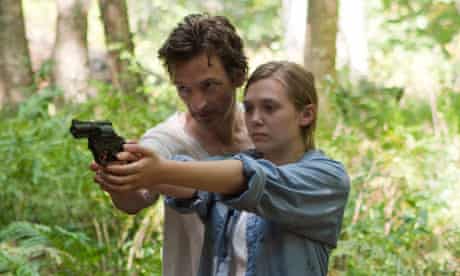Eye For Film >> Movies >> Martha Marcy May Marlene (2011) Film Review
Martha Marcy May Marlene
Reviewed by: Amber Wilkinson

There was an outbreak of cult films at Sundance 2011 - from joining one in Higher Ground, attempts to infiltrate one in Sound Of My Voice to the devastation they can commit in Kevin Smith's oddly pitched horror/action/comedy/politics mash-up Red State. The prize for creeping under your skin, however, has to go to Sean Durkin's debut feature Martha Marcy May Marlene - which is a whole lot more memorable and resonant than its cumbersome title.
Those four women are, in fact, just one - Martha (Elizabeth Olsen), who has fled a cult somewhere in the Catskills after being with them for two years. We join her as she runs to the nearest town and phones her estranged sister (Sarah Paulson). We then follow her over the course of the next three weeks as she tries to come to terms with what has happened to her, while her sister and husband (Hugh Dancy) try to work out what on earth has happened since they last saw her.

Flashbacks can often prove frustratingly confusing but here they work in dialogue with the present as Durkin weaves in and out of Martha's life with her family and her time with the cult. The juxtaposition emphasises her increasing fear and paranoia, while also drawing comparisons between her life 'before', 'during' and 'after' to help us understand the conflict between the attraction and repulsion which she feels for the 'family' she has fled.
Durkin's film is admirably ambiguous when it comes to the credo of the cult. This is not about religion and he is not interested in pointing the finger at any specific ideology. Instead, he is concerned with that essential horrific element that drives almost all such organisations - power and the abuse of it. This is a quiet film and all the more unsettling because of that. The leader Patrick (John Hawkes, as effortlessly menacing as he was in Winter's Bone) is the alpha male of the group, re-naming each member when he first meets them - "You look like a Marcy May," he tells her. And this is just the first step in stripping away each member's sense of self, so that they become fully indoctrinated into the group to the point where rape is looked upon as a treat. As Patrick puts it: "Fear is the most amazing emotion of all."
The film does build to fully fledged violence but much of the sense of dread is created by the eerie calmness with which bad things in the cult are allowed to happen as though they were as normal as brushing your teeth. The sound design accentuates the feeling of slow-burn menace, while Jody Lee Lipes cinematography cleverly exposes and explores the differences between the environment of the cult and Martha's sister's home.
Olsen, meanwhile, may be currently shackled with the tag of 'younger sister of the Olsen twins' but on the strength of this raw and magnetic performance that's unlikely to last and there's a good chance she will secure an Oscar nod.
Durkin is more interested in asking questions than offering easy answers, so those who like their endings to be cut and dried are likely to be frustrated by his refusal to bring cast-iron resolution. As a moody, atmospheric study of paranoia, however, it is hard to beat and it may well leave you feeling as haunted as Martha.
Reviewed on: 22 Aug 2011
















